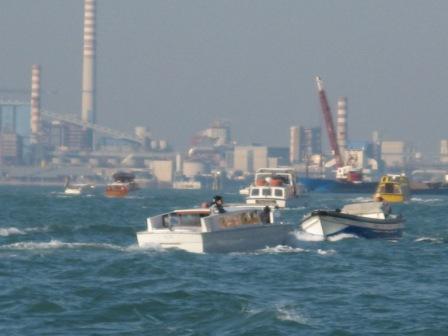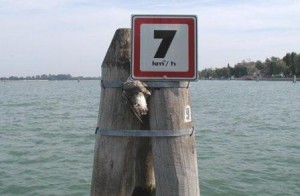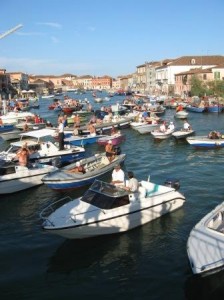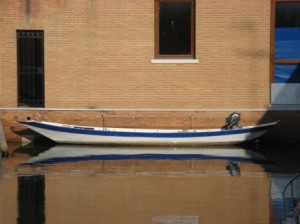Read Part 1: The What; Part 3: The How; Suck It Up; Part 4: The lagoon’s-eye view
If civilization has reached the stage where most people generally agree that it’s wrong to strike a woman, a child, even a dog, it’s not easy to explain, much less excuse, why an entire city should have to submit to this kind of abuse, a city which depends as much (or more) on its people than the people depend on it.
But then again, it is easy to explain. Sloth, egotism, and a resistance to contradiction tougher than corrugated iron induce almost all the people with motorboats of whatever size or purpose either to deny that they are creating waves, or say that other perpetrators are far more guilty, or accept it with Zen-like resignation.
All of these put together foster a situation in which a recent newspaper article could make a serious reference to the “numerous reports (to the police, of excessive traffic/waves) by Venetians who when they go out in their motorboats have to work miracles to avoid ending up in the water because the waves are so strong.”
People in motorboats complaining about waves. Let me stop and think about that for a minute.

Waves don’t really care who causes them or why, but each one acts as a hammer hitting anything it reaches. A study more than 10 years ago revealed, via sensors in the Grand Canal, that a wave hit a wall every 1 1/2 seconds. One pauses to imagine what the public response might be in a city — say, Rome — in which a heavily loaded truck ran into a building, especially a monument, every 1 1/2 seconds. Zen-like resignation doesn’t come to my mind.
For some reason, waves just don’t sound that bad. But they are. And even though they’re right out there in plain view, solutions — and many have been proposed, and re-proposed — have the doomed allure of the classic New Year’s diet: feasible, yet somehow impossible.
One reason is a lethargy at City Hall of spectacular dimensions caused, among several factors, by the lack of ability or desire on the part of the city’s administrators to resist the inevitable shrieking and ranting from any sector which feels threatened by any suggestion of limits. Example: The recent succumbing to pressure by the taxi drivers, and the awarding of 25 new taxi licenses. These will not be taxis which do not create waves, but they will be taxis traveling the same routes which already are suffering the most devastation.
These licenses were granted by the same officials who in other situations solemnly invoke the “battle against motondoso.” Hard to get anywhere with a battle when most of your officers are collaborating with the other side.

Of course there are laws — plenty of them. But they are only sluggishly enforced, especially those concerning speed limits. There are sporadic police “blitzes” which snag a certain number of offenders (it’s like shooting fish in a barrel), but these blitzes change nothing, not even for the people who have been handed fines. Taking your chances is part of the Mediterranean worldview, and laws are meant to be ignored. Fines are part of the annual budget for many waterborne enterprises. Confiscate your taxi? We’ve got more. One taxi owner invited some city politicians to the launching of his new one.
Down here at the waterline, I can tell you that one of the biggest obstacles to reducing waves is contained in three words: “Io devo lavorare” (Literally, “I have to work.” Figuratively, “Get off my back, do you want my wife and children to be thrown out onto the street to beg?”)
This phrase is lavishly used, on the assumption that it’s a free pass to whatever the person speaking it feels like doing. And when gondoliers stage one of their periodic protests, which are always dramatic because gondolas are inherently harmless, the little red “Danger: Irony” light starts to flash. Gondoliers spend all day carrying people around through waves that range from “unpleasant” to “dangerous” to “life-threatening” (not an exaggeration; occasional passengers have risked drowning, and some have succeeded). But several gondolier cooperatives do a very lucrative business owning and operating a fleet of mega-tourist launches.
My favorite little moment was when two gondoliers went to a meeting of Pax in Aqua, the citizens’ group committed to combating motondoso. They went in a motorboat.
It’s not that they should have swum there. I’m just saying.

I’ll tell you when I gave up. It wasn’t the Sunday afternoon we barely made it back alive rowing our little Venetian topetta from Bacan’, one of the most popular lagoon summer spots to hang out in boats, which means motorboats. The waves were heavy, frantic, aggressive; they came from every direction as boat wakes smashed into each other. So: No more Bacan’ for us. We can just stay home and take up paper-making. Problem solved.
No, I could hear the air seep out of my capacity to hope on another Sunday afternoon in 2002, I think it was, when we were walking along the rio di San Trovaso — a very narrow canal which is always busy because it’s one of the shortest cuts between the Giudecca Canal and the Grand Canal.
For weeks, maybe months, long warning strips of red and white tape had been strung along parts of the fondamenta bordering the canal because it had become so unsafe to walk on. The waves from the constant traffic had done their inevitable work weakening the sidewalks’ foundations, in which you could easily see cracks, cracks that were widening thanks to the waves rushing in and out, pulling the soil from beneath the paving stones. The whole walkway was ready to cave in.
In that period, the then-mayor Paolo Costa had tried a novel approach to the problem: He had appointed himself Special Commissioner against Motondoso, which gave him extraordinary powers to deal with the deteriorating situation and also — well, why not? — get an extra paycheck.
His idea was that the bureaucracy had proved incapable of dealing with the waterborne anarchy which is obviously destroying the city, and the police hadn’t been noticeably effective in enforcing the laws (which you could understand, seeing that there are so few police and so rarely are any dedicated to monitoring speed limits). Therefore a sort of instant dictator would have to step in to impose order.

The resulting special decree (Ordinanza n.09/2002, prot. 38/2002, February 21, 2002) outlines speed limits, and boat specifications, and canals name by name, to a degree which makes it clear that if every regulation were to be obeyed wars would cease, hunger would disappear, and illness and poverty would become but an ancestral bad dream. I’m sorry it’s only in Italian, it makes genuinely inspiring reading.
Suddenly we saw a motorboat come screaming down the canal, faster than any boat I’d ever seen here, hurling walls of white water against the trembling embankments. We stopped, stunned. Everybody walking along had stopped. Then the boat stopped. We heard voices. A few people on the sidewalk were talking to the people in the boat. And then it became clear.
They were filming “The Italian Job,” and this was just one of many sequences the city was to witness over the next few days or weeks (I can’t remember). Boats were racing up and down canals in a way that not even taxi-drivers could have dreamed of. Of course, if a taxi driver were to go this fast, he’d have to go to jail, or hell. For a movie, though — that’s something else entirely.
And who gave the permission for this film and these high-speed chases, and these walls of white water? The mayor. Excuse me, I meant the Special Commissioner against Motondoso.
I wish I could say I made that up, but I didn’t.
